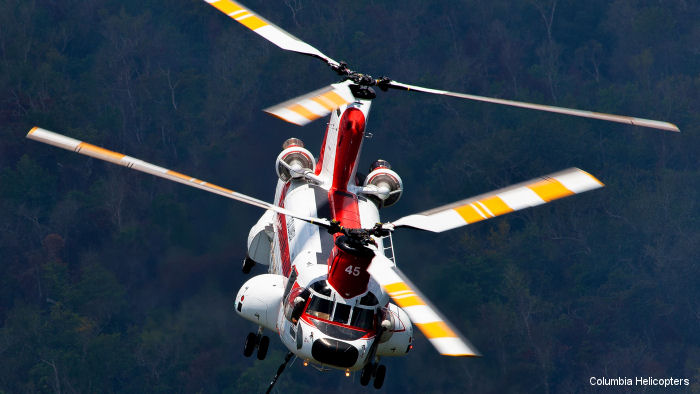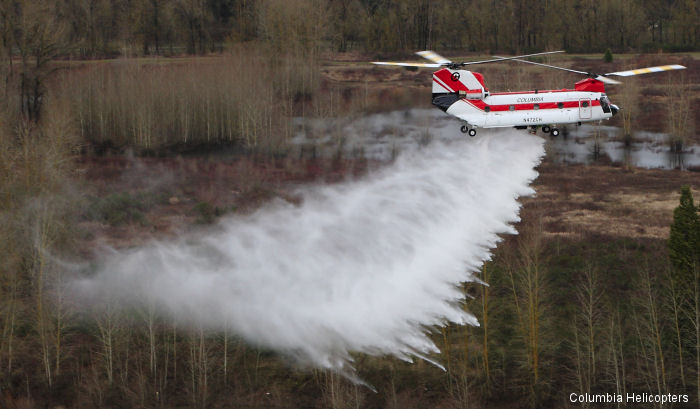AHSAFA, June 07, 2016 - WASHINGTON - Columbia Helicopters has successfully deployed a large helicopter equipped with an internal, high-capacity, fire suppression tanking system for the first time.
The helicopter, a CH-47D Chinook, was dispatched to a wildland fire from a US Forest Service (USFS) tanker base in Ely, Minnesota, on May 14. The mission, which dropped fire retardant, took about 90 minutes.
Jointly developed by Columbia Helicopters and Simplex Aerospace—both headquartered in Portland, Oregon--the Simplex Fire Attack System™ (FAS) was custom-designed and certified for application to the CH-47D Chinook under a supplemental type certificate (STC) issued to Simplex Aerospace. The STC gained Federal Aviation Administration (FAA) approval in December 2015. Columbia Helicopters currently owns 11 former US Military Chinooks, and has equipped two with the FAS to date. Both helicopters are operating under USFS exclusive use contracts.
With a 2,800 gallon capacity, the internal tank is thought to be the largest specifically designed for fire suppression, and certified for a helicopter, according to Cody Barton, Columbia Helicopters' Chief Flight Instructor and Command Pilot. "To our knowledge, there are no other helicopter operators in the world using an internal tank of that size, purpose-built for aerial firefighting," he said. "The system is compatible with water, foam, chemical retardant, or any other agent the USFS might supply."
Barton added that the performance of the new internal tank exceeded the company's expectations. "It is certainly a different method of firefighting, which brings a tremendous amount of value," he said.
Among the benefits Barton cited is the capability to use the helicopter for urban firefighting, since current US government regulations forbid the use of a traditional external bucket and long line system over structures and people. Also, he noted, since the tank is a semi-permanently installed system, the helicopter can be dispatched more quickly.
"With the internal tank, we just take off, and no longer have to take the time—about 20 minutes—to attach a 1,322 pound external bucket every time we need it," he said. "Then, once attached, the bucket generates turbulence in flight, and slows our airspeed to between 100-110 knots. With an internally mounted tank, we could do 130 knots, which gets us to the fire that much faster"
"When loaded with water," Barton said, "there is no real impact on aircraft handling. "We continue to have a very high degree of maneuverability, while maintaining operational safety standards."
Constructed as a single unit, the tank utilizes a roll-on/roll-off method of installation and removal, which can be done at field level. When installed, the tank is mounted over the cargo hook well, using specially designed components. The cargo hook was removed and the well underwent some modifications for the doors through which the water or retardant is dropped. The tanks can be filled directly from ground-based vehicles, or through a snorkel from lakes or streams. The doors and hover pump are controlled from the cockpit by the pilot.
"We have trained the pilots on the new tank system, which includes eight hours of ground school, and three hours of differences training," Barton explained.
"The internal tank project is another example of innovation initiated by and totally underwritten by a private operator in the aerial firefighting industry," said George Hill, Executive Director of the American Helicopter Services And Aerial Firefighting Association (AHSAFA). "As fire seasons get longer and more destructive, we believe that more potential opportunities to add new technologies will emerge, enhancing the efficiency of today's privately owned and operated aerial firefighting fleet."
Columbia Helicopters is a member of AHSAFA, the Washington-based trade association representing privately operated companies engaging in aerial firefighting.
The helicopter, a CH-47D Chinook, was dispatched to a wildland fire from a US Forest Service (USFS) tanker base in Ely, Minnesota, on May 14. The mission, which dropped fire retardant, took about 90 minutes.
Jointly developed by Columbia Helicopters and Simplex Aerospace—both headquartered in Portland, Oregon--the Simplex Fire Attack System™ (FAS) was custom-designed and certified for application to the CH-47D Chinook under a supplemental type certificate (STC) issued to Simplex Aerospace. The STC gained Federal Aviation Administration (FAA) approval in December 2015. Columbia Helicopters currently owns 11 former US Military Chinooks, and has equipped two with the FAS to date. Both helicopters are operating under USFS exclusive use contracts.
With a 2,800 gallon capacity, the internal tank is thought to be the largest specifically designed for fire suppression, and certified for a helicopter, according to Cody Barton, Columbia Helicopters' Chief Flight Instructor and Command Pilot. "To our knowledge, there are no other helicopter operators in the world using an internal tank of that size, purpose-built for aerial firefighting," he said. "The system is compatible with water, foam, chemical retardant, or any other agent the USFS might supply."
Barton added that the performance of the new internal tank exceeded the company's expectations. "It is certainly a different method of firefighting, which brings a tremendous amount of value," he said.
Among the benefits Barton cited is the capability to use the helicopter for urban firefighting, since current US government regulations forbid the use of a traditional external bucket and long line system over structures and people. Also, he noted, since the tank is a semi-permanently installed system, the helicopter can be dispatched more quickly.
"With the internal tank, we just take off, and no longer have to take the time—about 20 minutes—to attach a 1,322 pound external bucket every time we need it," he said. "Then, once attached, the bucket generates turbulence in flight, and slows our airspeed to between 100-110 knots. With an internally mounted tank, we could do 130 knots, which gets us to the fire that much faster"
"When loaded with water," Barton said, "there is no real impact on aircraft handling. "We continue to have a very high degree of maneuverability, while maintaining operational safety standards."
Constructed as a single unit, the tank utilizes a roll-on/roll-off method of installation and removal, which can be done at field level. When installed, the tank is mounted over the cargo hook well, using specially designed components. The cargo hook was removed and the well underwent some modifications for the doors through which the water or retardant is dropped. The tanks can be filled directly from ground-based vehicles, or through a snorkel from lakes or streams. The doors and hover pump are controlled from the cockpit by the pilot.
"We have trained the pilots on the new tank system, which includes eight hours of ground school, and three hours of differences training," Barton explained.
"The internal tank project is another example of innovation initiated by and totally underwritten by a private operator in the aerial firefighting industry," said George Hill, Executive Director of the American Helicopter Services And Aerial Firefighting Association (AHSAFA). "As fire seasons get longer and more destructive, we believe that more potential opportunities to add new technologies will emerge, enhancing the efficiency of today's privately owned and operated aerial firefighting fleet."
Columbia Helicopters is a member of AHSAFA, the Washington-based trade association representing privately operated companies engaging in aerial firefighting.
See also |
Commercial CH-47 in
Tanked Chinook Wins US Forest Service Contracts






